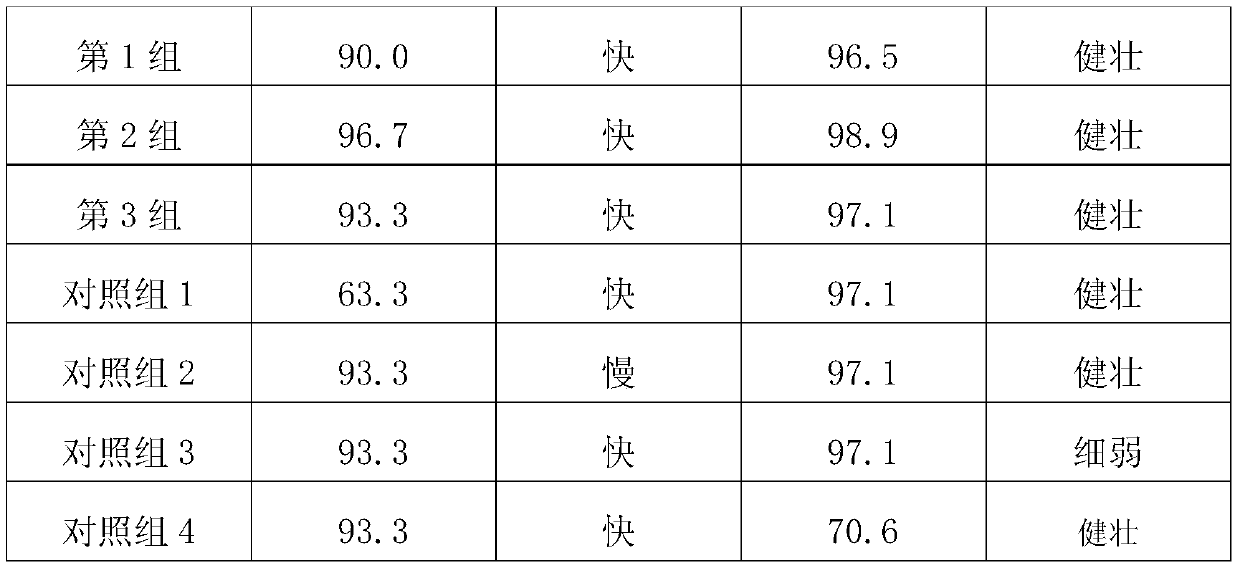A kind of common wild rice tissue culture rapid propagation method
A technique of tissue culture and wild rice, applied in horticultural methods, botany equipment and methods, plant regeneration, etc., can solve problems such as difficulty in harvesting mature seeds, difficulty in reproduction, strong seed dormancy, etc., to improve the quality of seedlings, improve Multiplication coefficient and effect of increasing germination rate
- Summary
- Abstract
- Description
- Claims
- Application Information
AI Technical Summary
Problems solved by technology
Method used
Image
Examples
Embodiment 1
[0026] A kind of common wild rice tissue culture rapid propagation method of the present embodiment comprises the following steps:
[0027] (1) Selection and disinfection of explants: take ordinary wild rice seeds as explants, remove the rice husk, soak for 5 minutes with a 1% detergent solution by volume, rinse with tap water for 10 minutes, and place at 75 % ethanol for 1 min, then soaked in 0.003% sodium hypochlorite solution containing 2% active oxygen for 5 min, finally rinsed with sterile water for 3 times, and blotted the surface moisture with sterilized filter paper to obtain explants; Sterile water is distilled water through autoclaving;
[0028](2) Germination of seeds to obtain aseptic test-tube plantlets: inoculate the explants obtained in step (1) into the first medium, and cultivate them in the dark at 22°C for 18 days, and obtain aseptic test-tube plantlets after the seeds germinate; The first medium is prepared by adding GA3 0.1mg / L, sucrose 20mg / L, agar 3mg / L...
Embodiment 2
[0034] A kind of common wild rice tissue culture rapid propagation method of the present embodiment comprises the following steps:
[0035] (1) Selection and disinfection of explants: take ordinary wild rice seeds as explants, remove the rice husk, soak for 15 minutes with a 2% detergent solution by volume, rinse with tap water for 20 minutes, and place them at 75 % ethanol for 2 min, then soaked in 0.006% sodium hypochlorite solution containing 2% active oxygen for 10 min, and finally rinsed with sterile water for 5 times, and blotted the surface moisture with sterile filter paper to obtain explants; Sterile water is distilled water through autoclaving;
[0036] (2) Germination of seeds to obtain aseptic test-tube plantlets: inoculate the explants obtained in step (1) into the first medium, and cultivate them in the dark at 26°C for 24 days, and obtain aseptic test-tube plantlets after the seeds germinate; The first medium is prepared by adding GA3 0.5mg / L, sucrose 25mg / L, a...
Embodiment 3
[0042] A kind of common wild rice tissue culture rapid propagation method of the present embodiment comprises the following steps:
[0043] (1) Selection and disinfection of explants: take ordinary wild rice seeds as explants, remove the husk, soak for 10 minutes with 1.5% detergent solution by volume, rinse with tap water for 15 minutes, and place them at 75 % ethanol for 1.5min, then soaked in 0.005% sodium hypochlorite solution containing 2% active oxygen for 8min, finally rinsed with sterile water for 4 times, and dried the surface moisture with sterile filter paper to obtain explants; , sterile water is distilled water through autoclaving;
[0044] (2) Germination of seeds to obtain aseptic test-tube plantlets: inoculate the explants obtained in step (1) into the first medium, and cultivate them in the dark at 24°C for 20 days, and obtain aseptic test-tube plantlets after the seeds germinate; The first medium is prepared by adding GA3 0.4mg / L, sucrose 23mg / L, agar 4mg / L ...
PUM
 Login to View More
Login to View More Abstract
Description
Claims
Application Information
 Login to View More
Login to View More - R&D
- Intellectual Property
- Life Sciences
- Materials
- Tech Scout
- Unparalleled Data Quality
- Higher Quality Content
- 60% Fewer Hallucinations
Browse by: Latest US Patents, China's latest patents, Technical Efficacy Thesaurus, Application Domain, Technology Topic, Popular Technical Reports.
© 2025 PatSnap. All rights reserved.Legal|Privacy policy|Modern Slavery Act Transparency Statement|Sitemap|About US| Contact US: help@patsnap.com


